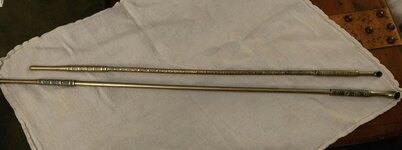I found these 2 pipes at a garage/antique sale 6 months ago. They are very similar in size, shape and design...but not identical. The previous owner thought they might be opium pipes and he had them behind a desk and we're not for sale. since I have never seen anything like them and he didn't really want to sell them...I paid $60 for the pair. I would like to find out as much as I can about them...age, value, origin, metal composition, use etc. Here are item specifics and descriptions to the best of my ability...
Pipe #1)
***size: 25" long . Width ranges from 1/4" to 1/2". Bowl at distal end is 1/2" in diameter
*** There is a 2 1/2" band of decoration and inlay near both of the ends. the design is tribal or oriental design... but I do see swastikas thruout too....I could be reading into that.
***inlay appears to be stone...possibly turquoise...and is a teal or dark Jade color with some sections a dark bluish purple. The pigment is not solid thruout each color and has the appearance of stone, marble, or granite consistency...but with a richer pigment. It could possibly be a glaze I suppose.
***The shaft between the decorative sections is smooth and even in texture.
***There is a ridge on underbelly of the bowl measuring 3/4" long.
***I'm not sure of the metal composition...it is durable, Won't bend or bow even under heavy force. NOT MAGNETIC. Its light gold I think it's brass.
***Black gu
Pipe #2)
***Size: slightly shorter then the first at 22" long. Width ranges from 1/4" to 1/2". Bowl at distal end is 1/4" in diameter. It is similar to the first one, but it looks like the bowl has been shortened.
***It has the decorative bands of inlay at each end, but they area in between is completely covered in the same design as the ends...and as pipe 1.
***The inlay is white and peach in color. It looks like it could possibly be residue of some sort instead of the original inlay. *** There is a ridge on the under side of the bowl as well, but this one is a copper color.
***There is wear in the middle where it would have been held.
***NOT MAGNETIC
***Black residue inside the bowl. White residue inside the mouthpiece of both pipes.
Please help me identify:
1)what it is
2)what it's made of
3)where it's from
4)how old it is
5)what it's worth


Pipe #1)
***size: 25" long . Width ranges from 1/4" to 1/2". Bowl at distal end is 1/2" in diameter
*** There is a 2 1/2" band of decoration and inlay near both of the ends. the design is tribal or oriental design... but I do see swastikas thruout too....I could be reading into that.
***inlay appears to be stone...possibly turquoise...and is a teal or dark Jade color with some sections a dark bluish purple. The pigment is not solid thruout each color and has the appearance of stone, marble, or granite consistency...but with a richer pigment. It could possibly be a glaze I suppose.
***The shaft between the decorative sections is smooth and even in texture.
***There is a ridge on underbelly of the bowl measuring 3/4" long.
***I'm not sure of the metal composition...it is durable, Won't bend or bow even under heavy force. NOT MAGNETIC. Its light gold I think it's brass.
***Black gu
Pipe #2)
***Size: slightly shorter then the first at 22" long. Width ranges from 1/4" to 1/2". Bowl at distal end is 1/4" in diameter. It is similar to the first one, but it looks like the bowl has been shortened.
***It has the decorative bands of inlay at each end, but they area in between is completely covered in the same design as the ends...and as pipe 1.
***The inlay is white and peach in color. It looks like it could possibly be residue of some sort instead of the original inlay. *** There is a ridge on the under side of the bowl as well, but this one is a copper color.
***There is wear in the middle where it would have been held.
***NOT MAGNETIC
***Black residue inside the bowl. White residue inside the mouthpiece of both pipes.
Please help me identify:
1)what it is
2)what it's made of
3)where it's from
4)how old it is
5)what it's worth


Attachments
Last edited:







